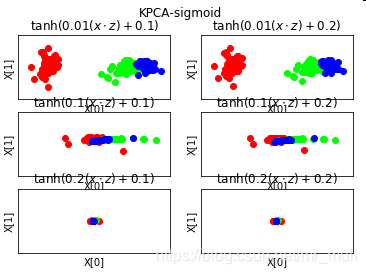機器學習之KPCA降維
阿新 • • 發佈:2018-11-29
- 機器學習之KPCA降維
# -*- coding: utf-8 -*- """ Created on Sun Nov 25 21:30:48 2018 @author: muli """ import numpy as np import matplotlib.pyplot as plt from sklearn import datasets,decomposition def load_data(): ''' 載入用於降維的資料 :return: 一個元組,依次為訓練樣本集和樣本集的標記 ''' iris=datasets.load_iris()# 使用 scikit-learn 自帶的 iris 資料集 return iris.data,iris.target def test_KPCA(*data): ''' 測試 KernelPCA 的用法 :param data: 可變引數。 它是一個元組,這裡要求其元素依次為:訓練樣本集、訓練樣本的標記 :return: None ''' X,y=data kernels=['linear','poly','rbf','sigmoid'] for kernel in kernels: kpca=decomposition.KernelPCA(n_components=None,kernel=kernel) # 依次測試四種核函式 kpca.fit(X) print(np.shape(kpca.lambdas_)) print("-----------") print('kernel=%s --> lambdas: %s'% (kernel,kpca.lambdas_)) def plot_KPCA(*data): ''' 繪製經過 KernelPCA 降維到二維之後的樣本點 :param data: 可變引數。它是一個元組,這裡要求其元素依次為:訓練樣本集、訓練樣本的標記 :return: None ''' X,y=data kernels=['linear','poly','rbf','sigmoid'] fig=plt.figure() colors=((1,0,0),(0,1,0),(0,0,1),(0.5,0.5,0),(0,0.5,0.5),(0.5,0,0.5), (0.4,0.6,0),(0.6,0.4,0),(0,0.6,0.4),(0.5,0.3,0.2),)# 顏色集合,不同標記的樣本染不同的顏色 for i,kernel in enumerate(kernels): kpca=decomposition.KernelPCA(n_components=2,kernel=kernel) kpca.fit(X) # 原始資料集轉換到二維 X_r=kpca.transform(X) ax=fig.add_subplot(2,2,i+1) ## 兩行兩列,每個單元顯示一種核函式的 KernelPCA 的效果圖 for label ,color in zip( np.unique(y),colors): position=y==label ax.scatter(X_r[position,0],X_r[position,1],label="target= %d"%label, color=color) ax.set_xlabel("X[0]") ax.set_ylabel("X[1]") # ax.legend(loc="best") ax.set_title("kernel=%s"%kernel) plt.suptitle("KPCA") plt.show() def plot_KPCA_poly(*data): ''' 繪製經過 使用 poly 核的KernelPCA 降維到二維之後的樣本點 :param data: 可變引數。 它是一個元組,這裡要求其元素依次為:訓練樣本集、訓練樣本的標記 :return: None ''' X,y=data fig=plt.figure() colors=((1,0,0),(0,1,0),(0,0,1),(0.5,0.5,0),(0,0.5,0.5),(0.5,0,0.5), (0.4,0.6,0),(0.6,0.4,0),(0,0.6,0.4),(0.5,0.3,0.2),)# 顏色集合,不同標記的樣本染不同的顏色 Params=[(3,1,1),(3,10,1),(3,1,10),(3,10,10),(10,1,1),(10,10,1),(10,1,10),(3,3,1)] # poly 核的引數組成的列表。 # 每個元素是個元組,代表一組引數(依次為:p 值, gamma 值, r 值) # p 取值為:3,10 # gamma 取值為 :1,10 # r 取值為:1,10 # 排列組合一共 8 種組合 for i,(p,gamma,r) in enumerate(Params): kpca=decomposition.KernelPCA(n_components=2,kernel='poly' ,gamma=gamma,degree=p,coef0=r) # poly 核,目標為2維 kpca.fit(X) X_r=kpca.transform(X)# 原始資料集轉換到二維 ax=fig.add_subplot(2,4,i+1)## 兩行四列,每個單元顯示核函式為 poly 的 KernelPCA 一組引數的效果圖 for label ,color in zip( np.unique(y),colors): position=y==label ax.scatter(X_r[position,0],X_r[position,1],label="target= %d"%label, color=color) ax.set_xlabel("X[0]") ax.set_xticks([]) # 隱藏 x 軸刻度 ax.set_yticks([]) # 隱藏 y 軸刻度 ax.set_ylabel("X[1]") # ax.legend(loc="best") ax.set_title(r"$ (%s (x \cdot z+1)+%s)^{%s}$"%(gamma,r,p)) plt.suptitle("KPCA-Poly") plt.show() def plot_KPCA_rbf(*data): ''' 繪製經過 使用 rbf 核的KernelPCA 降維到二維之後的樣本點 :param data: 可變引數。它是一個元組,這裡要求其元素依次為:訓練樣本集、訓練樣本的標記 :return: None ''' X,y=data fig=plt.figure() colors=((1,0,0),(0,1,0),(0,0,1),(0.5,0.5,0),(0,0.5,0.5),(0.5,0,0.5), (0.4,0.6,0),(0.6,0.4,0),(0,0.6,0.4),(0.5,0.3,0.2),)# 顏色集合,不同標記的樣本染不同的顏色 Gammas=[0.5,1,4,10]# rbf 核的引數組成的列表。每個引數就是 gamma值 for i,gamma in enumerate(Gammas): kpca=decomposition.KernelPCA(n_components=2,kernel='rbf',gamma=gamma) kpca.fit(X) X_r=kpca.transform(X)# 原始資料集轉換到二維 ax=fig.add_subplot(2,2,i+1)## 兩行兩列,每個單元顯示核函式為 rbf 的 KernelPCA 一組引數的效果圖 for label ,color in zip( np.unique(y),colors): position=y==label ax.scatter(X_r[position,0],X_r[position,1],label="target= %d"%label, color=color) ax.set_xlabel("X[0]") ax.set_xticks([]) # 隱藏 x 軸刻度 ax.set_yticks([]) # 隱藏 y 軸刻度 ax.set_ylabel("X[1]") # ax.legend(loc="best") ax.set_title(r"$\exp(-%s||x-z||^2)$"%gamma) plt.suptitle("KPCA-rbf") plt.show() def plot_KPCA_sigmoid(*data): ''' 繪製經過 使用 sigmoid 核的KernelPCA 降維到二維之後的樣本點 :param data: 可變引數。它是一個元組,這裡要求其元素依次為:訓練樣本集、訓練樣本的標記 :return: None ''' X,y=data fig=plt.figure() colors=((1,0,0),(0,1,0),(0,0,1),(0.5,0.5,0),(0,0.5,0.5),(0.5,0,0.5), (0.4,0.6,0),(0.6,0.4,0),(0,0.6,0.4),(0.5,0.3,0.2),)# 顏色集合,不同標記的樣本染不同的顏色 Params=[(0.01,0.1),(0.01,0.2),(0.1,0.1),(0.1,0.2),(0.2,0.1),(0.2,0.2)]# sigmoid 核的引數組成的列表。 # 每個元素就是一種引數組合(依次為 gamma,coef0) # gamma 取值為: 0.01,0.1,0.2 # coef0 取值為: 0.1,0.2 # 排列組合一共有 6 種組合 for i,(gamma,r) in enumerate(Params): kpca=decomposition.KernelPCA(n_components=2,kernel='sigmoid',gamma=gamma,coef0=r) kpca.fit(X) X_r=kpca.transform(X)# 原始資料集轉換到二維 ax=fig.add_subplot(3,2,i+1)## 三行兩列,每個單元顯示核函式為 sigmoid 的 KernelPCA 一組引數的效果圖 for label ,color in zip( np.unique(y),colors): position=y==label ax.scatter(X_r[position,0],X_r[position,1],label="target= %d"%label, color=color) ax.set_xlabel("X[0]") ax.set_xticks([]) # 隱藏 x 軸刻度 ax.set_yticks([]) # 隱藏 y 軸刻度 ax.set_ylabel("X[1]") # ax.legend(loc="best") ax.set_title(r"$\tanh(%s(x\cdot z)+%s)$"%(gamma,r)) plt.suptitle("KPCA-sigmoid") plt.show() if __name__=='__main__': X,y=load_data() # 產生用於降維的資料集 # test_KPCA(X,y) # 呼叫 test_KPCA # plot_KPCA(X,y) # 呼叫 plot_KPCA # plot_KPCA_poly(X,y) # 呼叫 plot_KPCA_poly # plot_KPCA_rbf(X,y) # 呼叫 plot_KPCA_rbf plot_KPCA_sigmoid(X,y) # 呼叫 plot_KPCA_sigmoid
- 如圖:

